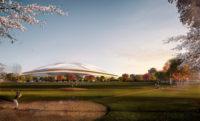In the latest round of public outcry over Tokyo’s 2020 Olympic Stadium, architect Arata Isozaki has stepped into the ring, joining a coterie of illustrious architects opposed to the project’s development.
Though he favored the initial helmet-shaped scheme that landed the London architect Zaha Hadid the commission, the revised design has Isozaki deeply concerned. He convened last week with Hadid associate Satoshi Ohashi at a public forum in Tokyo intended to give both parties the chance to speak their mind. The impetus for the event was the release of a statement written by Isozaki that harshly criticizes the stadium’s latest iteration. But in his document Isozaki also proposes a new approach to the stadium’s design that might enable the Japan Sport Council to have its cake and eat it too.
The scheme that has Isozaki up in arms came about in response to vociferous lobbying against Hadid’s original idea by both concerned citizens and architects who regarded her design as too big, too expensive, and too insensitive to the site, which is located in a tree-lined precinct amid the densely built heart of the city. Though reduced in size and toned down in its expression, Hadid’s current version of the stadium did not placate critics. Nor did it please Isozaki. “What remains is a dull, slow form … [I]f the stadium gets built the way it is, Tokyo will surely be burdened with a gigantic white elephant,” lamented Isozaki in his written statement. Despite the vehemence of this complaint, Ohashi reassured the audience that design development is proceeding on course. “When something is attention-getting, there are always people who criticize,” he explained.
But Isozaki sees the situation slightly differently. “Perhaps it is time to rethink this,” says the architect. “Too much is being asked of this stadium.” Instead, he recommends paring down the program by separating the main venue for athletic contests from the setting for the games’ opening and closing ceremonies—one of the main justifications for the required 80,000 seats.
Grandiose events marking the games’ start and finish have become an Olympics mainstay, but Isozaki reasons that it is now time to break that pattern by holding the ceremonies in a separate location: temporary grandstands set up in parkland across from the imperial palace. “Tokyo has the chance to be the first to set a new precedent,” says Isozaki. Upholding the competition results, Isozaki is proposing that Hadid design a downsized stadium while Kazuyo Sejima, who was a close contender for the commission, create the temporary structure.
To date, officials have yet to endorse any changes of this magnitude. And in the meantime Hadid continues to press on with design development. “We are very confident, committed, and capable of delivering a project of this scale,” asserts Ohashi. But the site has not been cleared and the 1964 Olympic stadium that will be torn down to make room for its replacement remains standing—reminders that it ain’t over till its over.





Post a comment to this article
Report Abusive Comment